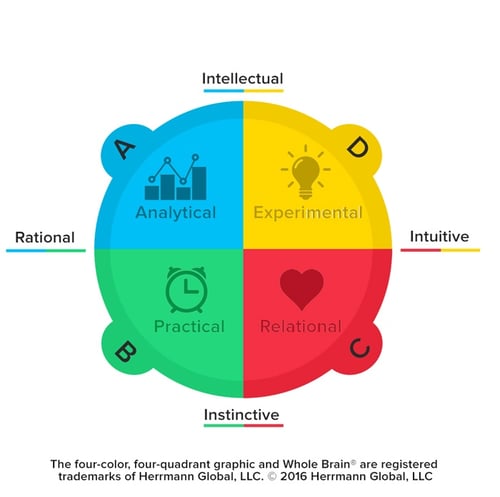This article is a guest post from Susanne Duke the founder of MARNI&Co., a consultancy that helps small and medium-sized companies sell and market like big brands.
Cognitive diversity is the inclusion of not only people with different ways of thinking but backgrounds, skills, strengths, and opinions. Teams that come together from differing departments encourage collaboration and innovation, creating a competitive advantage with customers.
Early in my career at Coca-Cola, I was a sales executive responsible for the value channel, which included customers like Family Dollar, Dollar General, and Dollar Tree. We had a small group of one or two calling on the corporate headquarters, but no cohesive account teams. At the time, Family Dollar was the only national retailer selling our products exclusively, but that competitive advantage was about to change. After a 20 year exclusive relationship, Family Dollar added Pepsi-Cola to the shelves, threatening our long-term partnership.
Given this competitive threat and the channel’s exponential growth, I joined the Family Dollar sales team to help build a cross-functional selling organization.
The first task was selecting the right team members for the job. We conducted countless interviews, talked to the leadership community, and studied strengths and backgrounds to ensure we had the most cognitively diverse team. We expanded our customer-facing field support to cover the growing number of new stores. But, most importantly, we recruited cross-functional teammates. We needed marketing, analytics, and operations to ensure we had a well-rounded account team to position Coca-Cola as Family Dollar’s most valued partner.
“Great vision without great people is irrelevant.” ― Jim Collins, Good to Great
Who should be on a cross-functional selling team?
Knowing we wanted to create a world-class selling team of cognitively diverse members, we used tools to identify strengths, like Myers Briggs, DISC, Standout Strengths, and one of my favorites, the Herrmann Whole Brain® Model.
HBDI® is a psychometric assessment that defines and describes the way people think into four quadrants: Analytical, Experimental, Relational, and Practical.
There are no right or wrong answers, only preferences. When faced with a problem, those in the analytical quadrant might seek out data, where an experimental thinker would hold a brainstorming session. Those focused on building relationships look to people to solve problems, while others want to get straight to the nuts and bolts of the program's execution.
HBDI® was invaluable as we built our team. We used the instrument to guide us through the recruiting and hiring process, creating a team with members in all four quadrants, both by role and preferred thinking style.
Who is on a cross-functional sales team?
National Sales Executive is often the most relationship-focused and leads the corporate customer account team. They are the primary contact for the customer, pulling together the cross-functional partners as the integrator. Orchestrating and bringing subject matter experts to solve customer problems. Often the opportunities involved our beverages, but also broader topics like supply chain efficiency or strategic initiatives like diversity and inclusion or partnership alliances.
Field Account Executives have similar responsibilities as the National Sales Executive but are aligned to the customer’s regions or divisions, orchestrating and facilitating programs on the local level.
Sign up to our newsletter for the latest insights
Category Analyst brings product and category insights to the table so the team and the customer can make informed, fact-based decisions.
Operations Leaders are the logistics and supply chain experts for the team. Ensuring the customer has the products or services as promised, when promised.
The team involves additional subject matter experts based on the project like legal, finance, public relations, or brand and product marketing. Each team member brings a new set of skills and a creative way of thinking.
Why should you create a cross-functional selling organization?
Putting together a cross-functional team is no easy task. It means aligning departments that have their own goals, leadership accountability, and performance metrics.
Departments with similar functions and thinking styles might have more agreement, but having the right amount of diversity will encourage the kind of friction that sparks creativity and innovation. Finding that balance and aligning across different departments and objectives is how world-class selling organizations create a competitive advantage.
Advantages of cross-functional selling teams:
- Flexible and faster decision making by removing common barriers
- Increased creativity and innovation through constant knowledge sharing
- Break down silos and encourage teamwork and collaboration between departments
- Ongoing leadership and career development even for individual contributors
Case study: leverage cognitive diversity to create customer value.
As a sales executive, I led the east division, and it was my responsibility to help Family Dollar transition from one exclusive beverage supplier to two. It was the largest territory with a lot of ground to cover, so I needed a scalable solution to replicate after testing.
My Family Dollar teammates and I learned a lot about building and championing a national customer team by creating one from the ground up. Now that we had diverse thinkers in place, we turned our focus to developing long-term customer value.
Although we all faced challenges in our area of expertise, we became accustomed to moving faster and with better results together, so I had an idea to join forces locally and create a cross-functional team within my territory.
I invited the customer, marketing, analytics, operation, and local distributor partners to a collaborate and innovate session, to pilot this idea with one Family Dollar region in the division.
We further divided the region into smaller geographic groups. At each table included cross-functional partners to help facilitate and lead the session. We kicked off the day with introductions and networking. We reviewed the data, insights, and reporting. We then wrapped up by brainstorming creative solutions to the most pressing customer problems, ideas like delivery frequency, display space, local marketing partnerships, and ways to increase communication and collaboration at the store level.
The team came up with over 25 ideas to help Family Dollar stores increase sales and efficiency and agreed to test five. We mapped out a 30-60-90-day plan to track and execute. By having attendees representing different roles and thinking styles, we could see the solutions’ practicality from all angles and quickly bring the ideas to life.
The Collaboration Session became a model of success.
- The test region saw an increase of 4% in sales over the next six months.
- The five ideas tested became national programs and rolled out to all 8,000 stores.
- Collaboration and Innovation sessions commercialized across the country.
- Our Family Dollar team became known as best in class collaborators, innovators, and team facilitators.
Win with customers:
The year after facing this critical mission, our Family Dollar customer team came together to win the category partnership award and the ultimate prize, the overall partner of the year. It was accomplished by understanding each team member’s strengths and working together to achieve a common goal through collaboration and innovative thinking.
In a year of uncertainty and a double-digit decline in our business, we found a way to create lifetime customer value with cross-functional diversity of thought and experience.

Proudly receiving the Partnership Award at the Family Dollar National Convention. Photo Credit: Family Dollar
What I learned about cross-functional teams from world-class brands:
I spent most of my career on national customer teams or leading across departments, so I have seen the power of cognitive diversity first hand.
Cross-functional teams are not without challenges, like mistrust, lack of understanding, misaligned goals, or opposing communication across departments, but in my opinion, the positives outweigh the potential risks, so I apply these principles to my business.
MARNI&Co. is not a large enterprise organization. However, we still leverage diverse thinking by partnering with freelancers and mentors to explore possibilities from different perspectives.
Regardless of your organization's size, here are few tips for creating and leading a cross-function team.
Tips for successfully leading cognitively diverse teams:
- Align goals and metrics for success across the organization to ensure that individuals and the department are heading in the same direction.
- Communicate team roles and responsibilities to eliminate confusion or duplication of efforts.
- Understand team strengths and gaps and make adjustments as needed.
- Set up a collaboration cadence and be able to facilitate meetings that bring diverse thinking styles together.
- Be able to influence across departments and at the most senior level to ensure your customer and your projects receive the needed support and resources.
- Continually steward team successes and ask for help when needed, keeping your team top of mind.
- Establish a shared collaboration tool that not only houses reports and documents but that tracks progress.
Regardless of your role or size of the organization, collaboration, communication, and customer value creation are skills for a lifetime.
World-class selling organizations use cognitive diversity to win with customers, and so can you.
Susanne Duke is a Whole Brain® Thinker, guest blogger, team leader, strategist, and explorer who enjoys coaching, speaking, and facilitating.
She is a small business champion and Founder of MARNI&Co., a consultancy that helps small and medium-sized companies sell and market like big brands.













